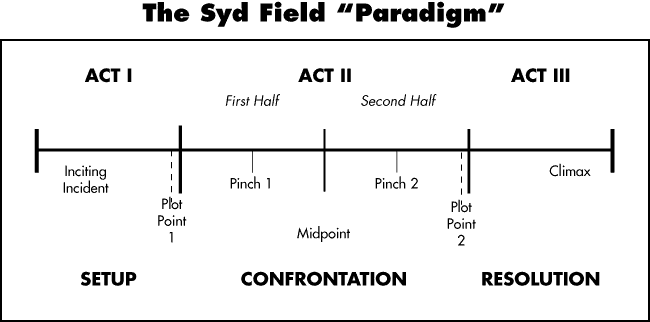Screen writing is a craft, a craft that can be learned. It is a definite craft, a definite art.

Structure is like gravity: It is the glue that holds the story in
place; it is the base, the foundation, the spine, the skeleton of the story. And it is this relationship between the parts and the whole that holds the screenplay together. It's what makes it what it is. It is the paradigm of dramatic structure.
A paradigm is a model, example, or conceptual scheme. This is the paradigm of a screenplay.
place; it is the base, the foundation, the spine, the skeleton of the story. And it is this relationship between the parts and the whole that holds the screenplay together. It's what makes it what it is. It is the paradigm of dramatic structure.
A paradigm is a model, example, or conceptual scheme. This is the paradigm of a screenplay.
Aristotle talked about the three unities of dramatic
action: time, place, and action. The normal Hollywood film is approximately two
hours long, or 120minutes; This is a standard length, That's approximately 128
pages of screenplay. One page of screen play is approximately one minute of
screen time. A page of screenplay equals a minute of screen time. It's a good
rule of thumb to follow.
ACT I IS THE SET-UP
Act I, the beginning, is a unit of dramatic action that
is approximately twenty or thirty pages long and is held together with the
dramatic context known as the Set-Up.
Context is the space that holds
something in place—in this case, the content. The context is what holds
the content in place.
In this unit of dramatic action, Act I, the
screenwriter sets up the story, establishes character, launches the
dramatic premise (what the story is about), illustrates the situation (the
circumstances surrounding the action), and creates the relationships between
the main character and the other characters who inhabit the landscape of his or
her world.
As a writer you've only got about ten minutes to
establish this, because the audience members can usually determine, either
consciously or unconsciously,
ACT II IS CONFRONTATION
Act II is a unit of dramatic action approximately sixty pages
long, and goes from the end of Act I, anywhere from pages20 to 30,to the end of
Act II, approximately pages 85 to 90, and is held together with the dramatic
context known as Confrontation.
During this second act the
main character encounters obstacle after obstacle that keeps him/her from
achieving his/her dramatic need,which is defined as what the character wants
to win, gain, get, or achieve during the course of the screenplay
All drama is conflict. Without conflict, you have no
action; without action, you have no character; without character, you have no story;
and without story, you have no screenplay.
ACT III IS RESOLUTION
Act III is a unit of dramatic action approximately twenty to thirty pages long
and goes from the end of Act II, approximately pages 85 to 90, to the end of
the screenplay. It is held together with the dramatic context known as Resolution.
Resolution does not mean ending; resolution means solution. Act III
is that unit of action that resolves the story. It is not the ending;
the ending is that specific scene or shot or sequence that ends the script.
Beginning, middle, and end; Act I, Act II, Act III. Set-Up,
Confrontation, Resolution—these parts make up the whole.

How
do you get from Act I, the Set-Up, to Act II, the Confrontation?
Or
And how do you get from Act
II to Act III,
the Resolution?
the Resolution?
To create a Plot Point at
the end of both Act I and Act II.
A Plot Point is
defined as any incident, episode, or event that
hooks into the action and spins it around in another direction.
In this
case, Plot Point I moves the action forward into Act II and Plot Point II moves
the action into Act III. Plot Point I occurs at the end of Act I, anywhere from
pages 20 to 25 or 30.
A Plot Point is always a function of the main character.
Plot Points serve an essential purpose in the
screenplay; they are a major story progression and keep the story line anchored
in place. Plot Points do not have to be big, dynamic scenes or sequences; they
can be quiet scenes in which a decision is made,
Plot Point II is really the same as Plot Point I; it is the way to
move the story forward, from Act II to Act III. It is a story progression. As
mentioned, it usually occurs anywhere between pages 80 or 90 of the screenplay.
What's the distinction between form and formula?
The paradigm is a form, not a formula. Structure is
what holds the story together. It is the spine, the skeleton. Story determines structure; structure doesn't determine story.
The form remains intact. A formula, however, is totally different. A
formula never varies; certain elements are put together so they come out exactly the same each
and every time. A screenplay, on the other hand, is unique, a totally
individual presentation.
The dramatic
structure of the screenplay maybe defined as a linear arrangement of related
incidents, episodes, or events leading to a dramatic resolution.
The paradigm is a model, an example, or a conceptual scheme; it is what
a well-structured screenplay looks like, an overview of the story line as it
unfolds from beginning to end.
Screenplays that work follow the paradigm. But don't take my word for it. Go to
a movie and see whether you can determine its structure for yourself.
told with pictures.
You should also read as many screenplays as possible in order to expand your
awareness of the form and structure.
The paradigm works.
It is the foundation of every good screenplay, the foundation of dramatic
structure.



















0 comments:
Post a Comment